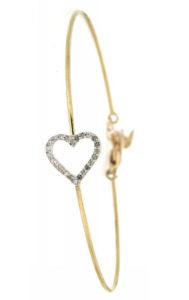Value-Able Jewelry
 Given the economic climate and soaring precious metal prices, more flexibility and inventiveness remains a key part of style. Jewelry manufacturers are expanding the materials they use and how they use them. The new focus is on innovating creative approaches in design, both technical and artistic.
Given the economic climate and soaring precious metal prices, more flexibility and inventiveness remains a key part of style. Jewelry manufacturers are expanding the materials they use and how they use them. The new focus is on innovating creative approaches in design, both technical and artistic.
Upping the ante on the wow factor, designers use diamonds, gems and pearls with silver, cooper, brass, and contemporary metals and alternative alloys, even organic elements like bone and wood and manmade materials like rubber and resin. Demand is strong for different gold colors, notably rose and blackened.
“All market segments are more open to greater variety of materials in design, most notably new, affordable alloys,” says Liz Chatelain, president of MVI Marketing, Paso Robles, California. “Jewelers should throw out the rulebook and stop being the gatekeepers of what’s acceptable for today’s consumers.”
Research by MVI’s Jewelry Consumer Opinion Council reveals that as long as a design has some precious element, it retains its intrinsic value for consumers who want jewelry that’s well made, looks nice and is reasonably priced.
 Capitalizing on the trend for new alloys and the absence of a yellow metal alternative, MJJ Brilliant introduced YellOra™—25 percent 24K, 21 percent silver, and 2 percent palladium mixed with proprietary alloys. “The intrinsic value is in the blend of these precious metals—the radiance of gold, strength of silver, rarity of palladium—to create an alloy that’s more affordable than traditional gold, more durable than gold-plated, and retains its gold color throughout,” tells Adam Gerber of the New York based manufacturer. The alloy is about 25 percent less in price than 10K gold, 40 percent less than 14K.
Capitalizing on the trend for new alloys and the absence of a yellow metal alternative, MJJ Brilliant introduced YellOra™—25 percent 24K, 21 percent silver, and 2 percent palladium mixed with proprietary alloys. “The intrinsic value is in the blend of these precious metals—the radiance of gold, strength of silver, rarity of palladium—to create an alloy that’s more affordable than traditional gold, more durable than gold-plated, and retains its gold color throughout,” tells Adam Gerber of the New York based manufacturer. The alloy is about 25 percent less in price than 10K gold, 40 percent less than 14K.
In the face of great choices in different alloys and metal processes, what has become clear is that the consumer wants clarity, tells Mark Hanna, chief marketing officer for Richline, New York. He reports a strong movement to define and narrow offerings based on what they represent. “Market confusion, which causes purchase paralysis, has inspired consumers to go with what they know. The biggest demand for us has been in silver with 14K gold.”
 Underscoring the significance of silver in fine jewelry is its demand in bridal, which Chatelain hails a mainstay no matter how well the economy rebounds. Maren Rosen, bridal director for Stuller, Lafayette, Louisiana explains: “Silver diamond bridal is a growing category that’s working because it’s viewed as a precious metal, and it sits at an attractive price point. We’ve embraced this and are developing a bridal line in our newest tarnish-resistant silver, Continuum™, designed to securely hold diamonds and large gemstones.”
Underscoring the significance of silver in fine jewelry is its demand in bridal, which Chatelain hails a mainstay no matter how well the economy rebounds. Maren Rosen, bridal director for Stuller, Lafayette, Louisiana explains: “Silver diamond bridal is a growing category that’s working because it’s viewed as a precious metal, and it sits at an attractive price point. We’ve embraced this and are developing a bridal line in our newest tarnish-resistant silver, Continuum™, designed to securely hold diamonds and large gemstones.”
Silver is a core component in pearl jewelry as well, offering big bang for the buck, especially when mixed with Chinese freshwaters, tells Peter Bazar, president of Imperial Pearl, East Providence, Rhode Island, who hails natural pastel colors and big sizes in the spotlight.
The affordability of Chinese freshwater pearls has encouraged manufacturers to take more chances in design. “This  started with our ‘Floaters’ (pearls on monofilament wire) and ‘Pearl and Leather’,” says Michael Schechter, digital marketing director for the New York-based pearl house, Honora. “Our customers loved seeing a new kind of pearl jewelry. Once we expanded on this sense of risk by creating an array of infused colors, there truly was something for everyone.”
started with our ‘Floaters’ (pearls on monofilament wire) and ‘Pearl and Leather’,” says Michael Schechter, digital marketing director for the New York-based pearl house, Honora. “Our customers loved seeing a new kind of pearl jewelry. Once we expanded on this sense of risk by creating an array of infused colors, there truly was something for everyone.”
These products, Schechter says, provide less of an entry barrier, making it easier for new customers to give Honora a try, while creating an opportunity for it to look at long-term relationships, rather than focus only on one-time sales.
This multi-sale approach applies not only to pearls, but also diamonds, gems and gold, creating an opportunity for customers to collect a diverse jewelry wardrobe.







